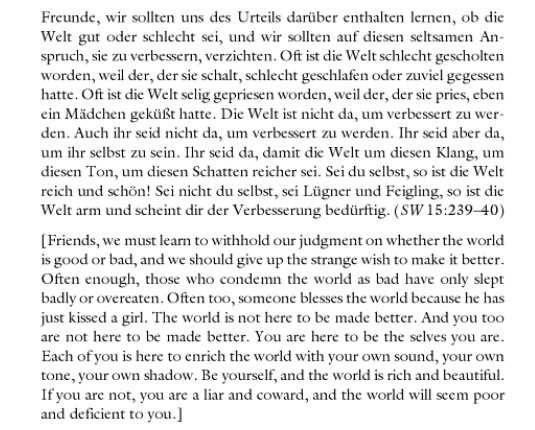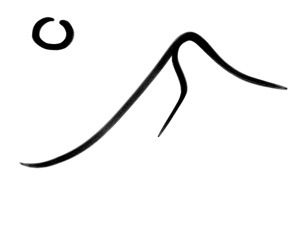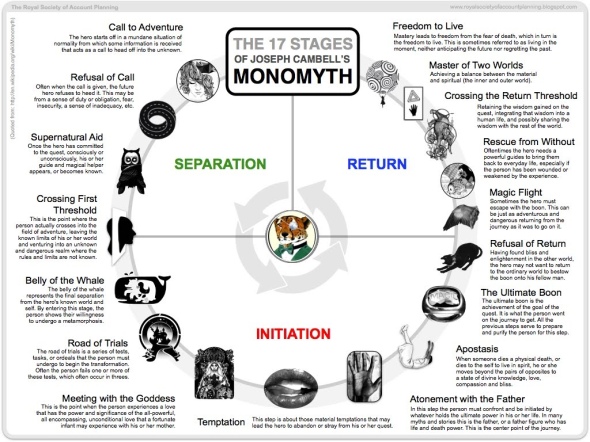Quote from Hermann Hesse
Posted: October 15, 2013 Filed under: Living in Truthless Truth | Tags: improvement, self 3 CommentsWise words from the German-born, Swiss poet and novelist (“Steppenwolf”, “Siddhartha”):
Unknowing
Posted: January 31, 2013 Filed under: Poetry | Tags: change, dream, illusion, life, potential, Purpose, self, separation, time 6 CommentsThe universe makes most sense by not making much sense.
As its purpose is to have no particular purpose,
It has infinite creative potential.
It moves as it stays and stays as it moves.
As change is its only constant,
It remains forever the same.
It has always been going on without going anywhere.
As it has never started and will never end,
Time does not apply to it.
It gives rise to all pairs of opposites.
And as the source of everything,
Nothing exists apart of it.
You are neither its puppet nor its master.
These ideas are based on self and other,
But such separation never took place.
There is only all-self which is all-other,
Forever re-creating itself out of itself.
We are IT dreaming we are other.
Now, wake up.
But beware.
The juice of life is in the dream.
The ‘Holy’ Grail
Posted: July 3, 2012 Filed under: Pointers | Tags: atonement, dark night, duality, ego, healing, now, Oneness, self, surrender Leave a commentBefore you read on, close your eyes quickly and ask yourself: what is the most important thing in life?
I bet you did not come up with specific acquisitions or achievements but with something emotional, something related to the quality of your experience, like to love, to live your dreams, to be of service to others, etc. What this little thought-experiment shows is that what we all seem to be striving for in life is not to accumulate ‘things’ or ‘success stories’ but experiences of life. Or in short: the most important thing in life is to be truly alive.
To truly live does not sound to be too hard a thing to accomplish, doesn’t it? The great Oscar Wilde would have disagreed, though, stating that “to live is the rarest thing in the world – most people exist, that is all.” Why is it, then, that although we are striving for more ‘life’ in our lives most of us seem to fail quiet miserably at it and end up merely ‘existing’?
The quest for the elixir of (more) ‘life’ is a recurring mythological theme. In the Grail legend, for example, there is the fisher king who reigns over a kingdom that has degenerated into an infertile wasteland ever since he had gotten a mysterious injury for which there was no cure. Only the legendary Grail was said to be able to heal the king’s wound and thereby restore the kingdom to its splendor of the old days. While the wound in this myth symbolizes the king’s impaired capacity to fully experience life (his kingdom!) in all its greatness, the Grail is that which can bring back the juice into a lifeless existence.
So, what is the ‘holy’ Grail? Where can it be found? In the Grail legend, the knights of the kingdom in demise who are called to find it, all set out in different directions. That is to say, the Grail can be found in many places. If you read my last post about the different ‘Way’s of the Bodhisattva’ you know that I posited that the Grail, whose healing powers are none other than those of the ‘Now’, is present in any self-referencing and self-sufficient activity or symbol since either possesses the capacity to -at least temporarily- cut through the subject/ object duality which otherwise covers the ‘Now’ in a thick cloud of fear and desire.
What the Grail legend with all the ordeals the knights have to go through is also telling us is that to live, to be truly alive, we first need to make sure we are facing our experiences. Although that sounds rather straightforward and easy enough, it actually isn’t. Because non-disalignment with our experience means that we not only ‘flow’ along with ‘pleasurable’ experiences but also with the ‘unpleasurable’ ones. It means saying ‘yes’ to everything. If we repress or hide from ‘unpleasant’ experiences, we become emotionally and experientially numb. Just like in the story of the fisher king, any inability to properly attend to our emotional pain slowly grows into a disability turning our worlds, our kingdoms, into dry wastelands ruled by hidden dragons in our unconscious. The famous motivational speaker Jim Rohn was spot on when he said that “the walls we build around us to keep the sadness out also keep out the joy”.
While the ‘artistic’ knight may use his or her artistic craft to deal with and release emotional pain, the ‘spiritual’ knight, lacking such a craft, heals his- or her psyche by surrendering to and, thereby, accepting all experiences unconditionally. (S)he does so by cultivating non-judgemental awareness to all that ‘is’. This cultivation, sometimes called ‘meditation’, reaches its climax when (s)he identifies with the indiscriminating, unconditionally loving awareness itself or, alternatively, when (s)he has realized that all that ‘is’, even the ‘unpleasant’ experiences are non other than the fundamental reality (emptiness) manifest as relative reality (form).
Surrendering is the process of purification (or purgatory) any ‘spiritual’ knight has to pass through to be eligible for the final, grand at-one-ment. The deeper (s)he dares to surrender, the more deeply buried, repressed emotional pain and trauma is released from the darkness of the unconscious to be subsequently burnt in the light of consciousness. As the difficult ‘healing’ process in this ‘dark night of the soul’ progresses, resistance to the phenomenal world starts to fade, calming the ‘spiritual’ knight’s mind and gradually tearing down the imaginary walls that create the sense of an isolated ‘self’. As a result, the whereabouts of the Grail become more and more intuitively known.
No matter how much the ‘spiritual’ knight surrenders, though, the notion of subject-object will still hold, and as long as this is the case, thought-waves of separation will have a recipient, a shore to crash upon. The ‘spiritual’ knight who wants to get hold of the Grail once and for all and, thereby, become a sage, thus, needs to go one final step further: the notion of a subject surrendering to an object has to let go of. (S)he needs to realize his- or herself to be inseparable of all that ‘is’, of this ‘One’ which encompasses both, ocean and waves, emptiness and form, of ‘That’ which is no-thing because it is every-thing. In this realization the ‘self’, finally known to be illusory, a mirage, ‘dies’ to be resurrected into the ‘spirit’. Henceforth, thought-waves ridden by fear and desire originating from the trance of separation between the individual and its environment, simply fade out in the vastness of the ocean unclaimed. Surrendering then becomes an impossibility, as it is known that there is no-body to surrender to any-thing since there is no-thing apart from every-thing (which of course, and quiet paradoxically, is the most complete form of surrender). In the discovery of the ‘un-reality’ of the self, the ‘holy’ Grail naturally reveals itself as having never been lost, yielding its boon to the ‘spiritual’ knight of being able to peacefully rest in the abundance of the eternal ‘Now’.
“What we are really living for is the experience of life, both the pain and the pleasure.”
~Joseph Campbell



